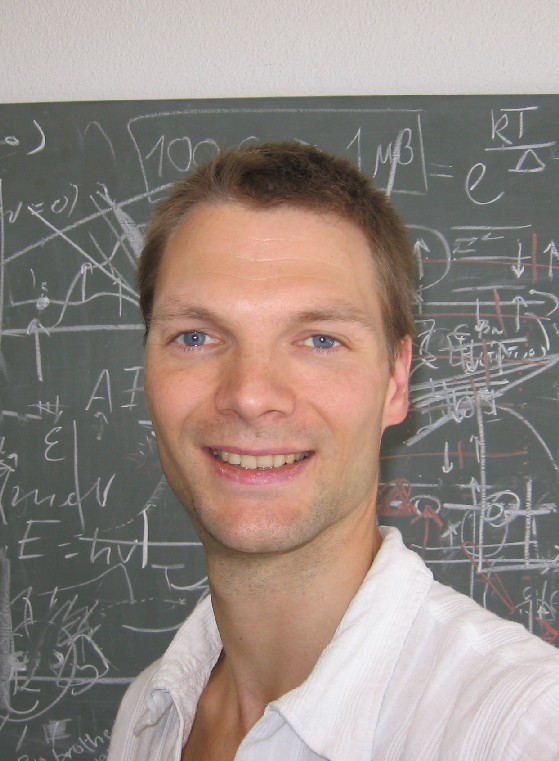
Henrik M. Rønnow was born in Copenhagen, Denmark. He has obtained a B.Sc in Physics (1994), a B.Sc in Mathematics (1995) and a M.Sc. in Physics (1996) at University of Copenhagen. He obtained his PhD also from University of Copenhagen in 2000.
He has occupied research positions at CEA-Grenoble (France), NEC-Laboratories Inc., Princeton (NJ, USA), James Franck Institute (Chicago, USA), London Centre for Nanotechnology (London, UK), Paul Scherrer Institut and ETH-Zurich, (Switzerland).
Prof. Henrik M. Rønnow is an associate professor at the Faculty of Basic Sciences at the EPFL where he founded the Laboratory for Quantum Magnetism (LQM) in 2007. His international standing, is documented by over 200 publications, over 5000 citations and an h-factor of 38.
At the EPFL, he teaches General Physics (electromagnetism), Introduction to Solid State Physics and has created new courses including Solid State Physics IV and Solid State Physics X for undergraduate and graduate students, respectively.
Research Interests
Prof. Ronnow’s research focuses on quantum magnetism, strongly correlated electron phenomena and materials with novel electronic properties, including high-temperature superconductors, CMR manganites and skyrmion hosting materials. Some of the most notable contributions to the research fields have been:
i) Neutron investigation of the incommensurate soliton lattice and excitations thereof in the high-field phase of the spin-Peierls material CuGeO3, 2 PRLs.
ii) Arguably the most comprehensive experimental account for a 2D S=½ square lattice Heisenberg antiferromagnet, 1 Nature Physics, 1 Proc Natl Acad Sci, 2 PRLs.
iii) Universality and field-dependence of the magnetic fluctuations in the high-temperature cuprate superconductors, 3 PRL, 1 Nature, 1 Nature Materials, 1 Nature Physics.
iv) Studies of purely dipolar coupled quantum magnets, including discovery of incomplete electronic softening at the quantum phase transition of the transverse field Ising model, when coupled to a nuclear spin bath, 1 Science, 1 PRB [27,40], and discovery of dimensional reduction in a dipolar coupled antiferromagnet. 1 Science, 1 PRL.
v) Demonstrated 2D metallicity and polaron imaging by STM on a bi-layered manganite 1 Nature, 1 book chapter.
vi) Several pioneering contributions to the emerging field of magnetic skyrmions: Firste demonstration of electric field control PRL, first material hosting skyrmions at room temperature Nat Comm, Nat Mat, first Neel-type skyrions Nat Mat.
vii) Invention of a new type of neutron spectrometer – The CAMEA concept, which was recently commissioned at the Swiss Neutron Source at the Paul Scherrer Institut, and is under construction at the future European Spallation Source in Sweden.
Selected Publications
- Zayed, M. E. et al. “4-Spin Plaquette Singlet State in the Shastry–Sutherland Compound SrCu2(BO3)2”. Nature Physics 13, 962–966 (2017). https://doi.org/10.1038/nphys4190
- Sutter, D. et al. “Hallmarks of Hunds Coupling in the Mott Insulator Ca2RuO4”. Nature Communications 8, 15176 (2017). https://doi.org/10.1038/ncomms15176
- Tóth, S. et al. “Electromagnon Dispersion Probed by Inelastic X-Ray Scattering in LiCrO2”. Nature Communications 7, 13547 (2016). https://doi.org/10.1038/ncomms13547
- Kimura, K. et al. “Magnetodielectric Detection of Magnetic Quadrupole Order in Ba(TiO)Cu4(PO4)4 with Cu4O12 Square Cupolas”. Nature Communications 7, 13039 (2016). https://doi.org/10.1038/ncomms13039
- Levatić, I. et al. “Dramatic Pressure-Driven Enhancement of Bulk Skyrmion Stability”. Sci Rep 6, (2016). https://doi.org/10.1038/srep21347
- Karube, K. et al. “Robust Metastable Skyrmions and Their Triangular-Square Lattice Structural Transition in a High-Temperature Chiral Magnet”. Nat Mater 15, 1237–1242 (2016). https://doi.org/10.1038/nmat4752
- Kézsmárki, I. et al. “Néel-Type Skyrmion Lattice with Confined Orientation in the Polar Magnetic Semiconductor GaV4S8”. Nat Mater 14, 1116–1122 (2015). https://doi.org/10.1038/nmat4402
- Tokunaga, Y. et al. “A New Class of Chiral Materials Hosting Magnetic Skyrmions beyond Room Temperature”. Nature Communications 6, 7638 (2015). https://doi.org/10.1038/ncomms8638
- Dalla Piazza, B. et al. “Fractional Excitations in the Square-Lattice Quantum Antiferromagnet”. Nature Physics 11, 62–68 (2015). https://doi.org/10.1038/nphys3172
- Guarise, M. et al. “Anisotropic Softening of Magnetic Excitations along the Nodal Direction in Superconducting Cuprates”. Nature Communications 5, 5760 (2014). https://doi.org/10.1038/ncomms6760